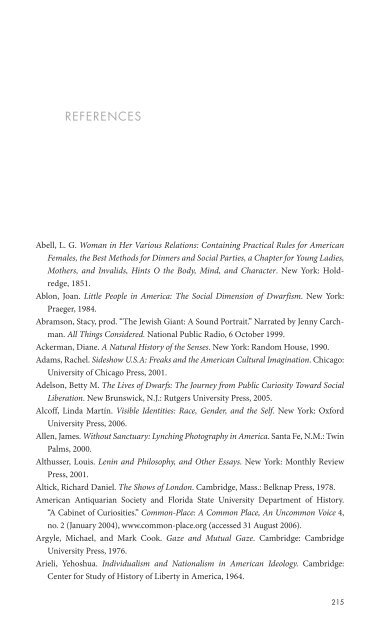Staring how we look sobre la mirada.pdf - artecolonial
Staring how we look sobre la mirada.pdf - artecolonial
Staring how we look sobre la mirada.pdf - artecolonial
You also want an ePaper? Increase the reach of your titles
YUMPU automatically turns print PDFs into web optimized ePapers that Google loves.
FACES 103<br />
Familiarity determines our ability to know faces. All people, for example,<br />
are poorer at recognizing faces from races other than their own. Experiments<br />
that distort photos of faces by changing the spatial re<strong>la</strong>tions among components<br />
confuse face perception. We also have trouble recognizing inverted faces<br />
but not inverted objects. Visual perception studies suggest that <strong>we</strong> recognize<br />
faces as undifferentiated wholes rather than by way of their constituent parts<br />
(Peterson and Rhodes 2003). Such research suggests that competent, efficient<br />
facial recognition depends on encountering faces that meet certain<br />
visual expectations. In other words, an internalized facial norm shaped by<br />
culture—what psychologists call “norm based coding”—determines facial<br />
legibility (Rhodes and Tremewan 1994, 279). As long as <strong>we</strong> are seeing the<br />
kinds of faces <strong>we</strong> are accustomed to coming across, visual cognition and<br />
the social re<strong>la</strong>tions that accompany them go smoothly. The unexpected face<br />
confounds us, presses us—and thus makes us stare. This visual indeterminacy<br />
is more than a cognitive problem, <strong>how</strong>ever. Illegible faces are a social<br />
problem, too.<br />
FACE-WORK<br />
What sociologist Erving Goffman calls “face-work” demands staring. Facework<br />
extends both reading and recognizing faces into an interactive social<br />
drama of self-management and status negotiation. Face-work is an exacting<br />
interchange of mutual scrutiny, adjustment, call, and response in which<br />
visual vigi<strong>la</strong>nce is crucial. Because <strong>we</strong> recognize ourselves in the faces of<br />
others, <strong>we</strong> often seek out faces <strong>we</strong> suspect will tell us what <strong>we</strong> want or need<br />
to know about who <strong>we</strong> are in the social world. In this process, <strong>we</strong> first visually<br />
identify a face with which <strong>we</strong> want to engage and then stare at it<br />
intently to discern its response to the face <strong>we</strong> have put forward. Goffman’s<br />
work emphasizes that such face-work is more than simple individualized<br />
communication; rather, the ways that <strong>we</strong> stare at one another are highly<br />
ritualized ceremonies of regard acted out anew in each staring encounter<br />
(Goffman et al. 1988).<br />
Face-work is exacting and potentially perilous. We can be “out of face” if<br />
<strong>we</strong> are unprepared to perform according to expected conventions (Goffman<br />
1982, 8). We are in the “wrong face” when information surfaces that threatens<br />
the face <strong>we</strong> put forward. We try to use the social tool Goffman calls<br />
“poise” to conceal any shamefacedness that comes from having the wrong<br />
face or being out of face. Failures of poise can be, for example, faltering conversational<br />
fluency like forgetting someone’s name, the emergence of unf<strong>la</strong>ttering<br />
information such as a lost job, or breaches of c<strong>la</strong>ss etiquette such


